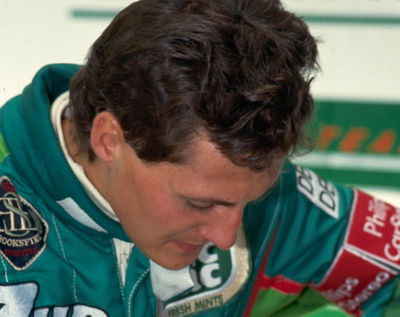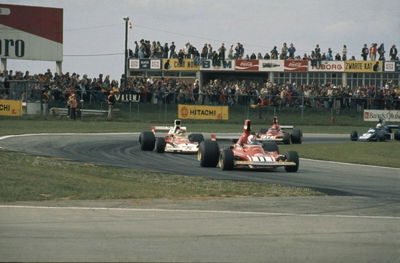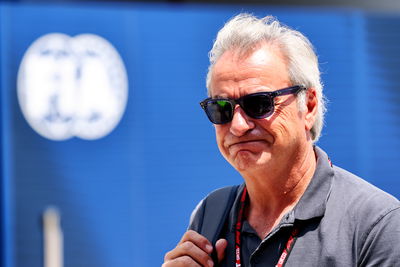25 Years of Michael Schumacher - F1's superb super-subs

By Ollie BarstowFollow @OllieBarstow on Twitter
No visit to Spa-Francorchamps and the Belgian Grand Prix each year is complete without a nod to the legend that is Michael Schumacher, who made his debut here back in 1991.
Starting along the path that would see him go on to become the most successful grand prix driver of all time, memories of that stunning debut for Jordan 25 years ago are made all the more pertinent in the shadow of his current well-being more than 2 years after his serious skiing accident.
At the time a 'mere' stand-in at Jordan for a single race before Benetton quickly spotted his talent and snapped him up, we look back on that debut and other eye-catching super-subs from F1's past...
(To clarify: This list compiles 'substitutes', not 'replacements'... definition being they returned their seats. For instance, Mika Hakkinen and Robert Kubica are not eligible as they retained drives with the team after their debut)
 |
| Michael Schumacher may have not even completed a lap of his F1 race debut, but his one weekend with Jordan caught the eye of Benetton... and the rest is history |
The most famous 'super-sub' of them all, the then-little known Michael Schumacher made his one and only - yet remarkably memorable - appearance for the 'rookie' Jordan team at the 1991 Belgian Grand Prix in place of local hero Bertrand Gachot, sacked after being handed a two-month prison sentence for using CS spray against a taxi driver.
With Mercedes sweetening the deal with a financial contribution having honed his skills through its sportscar programme, Schumacher arrived in Belgium having driven the Jordan 191 just once at a Silverstone test, while he had never sampled the Spa-Francorchamps circuit that would go on to become his most famous haunt.
A reminder that you can impress on the back of qualifying alone, Schumacher started an exceptional seventh - ahead of experienced team-mate Andrea de Cesaris -, only for his race to last just one lap when the clutch failed. Regardless, it was enough to make Benetton to sit up and take notice.
Quickly swooping to grab the German with a better deal than F1-absent Mercedes could possibly counter with, the rest is very much history in this case, Schumacher becoming champion within three years to win the first of seven world titles that would establish him the greatest F1 driver in history... and this without completing a single race lap!
Alex WurzBenetton-Renault3 racesHighlight: 1997 British Grand Prix
Little known when he made his F1 debut back in 1997, the then 23 year-old Alex Wurz hit the big time when he was called up to replace the unwell and grieving Gerhard Berger in the Benetton-Renault team for three races. Prior to F1, Wurz had already become the youngest ever Le Mans winner and was racing in International Touring Cars, but his single-seater credentials were limited to respectable performances in German F3 only.
Nevertheless, he settled in with aplomb and whilst his first two outings yielded DNFs, Wurz - receiving an extended stay after Berger's father was killed in a plane crash - hooked it up in his final attempt with a measured drive to third place at Silverstone just behind his team-mate Jean Alesi, a performance that also briefly saw him lead between pit-stops.
Though Berger was back in the B197 for the next race in Germany - which he went on to famously win -, Wurz had convinced Benetton to sign him full-time for 1998, even if the declining team never enjoyed the same competitiveness thereafter.
Beyond Benetton, Wurz went on to become a prolific test driver amidst his total 69 starts between 1997 and his final race in 2007, one such stint with McLaren seeing him make a single race appearance for the team where he once again proved a substitute star, finishing third in the 2005 San Marino Grand Prix.
Another Le Mans title came in 2009 with Peugeot and, now retired, Wurz has been established as the President of the Grand Prix Drivers' Association... quite the journey from humble beginnings.
 |
| Sebastian Vettel became the youngest driver to score an F1 point on his one and only showing for BMW before Red Bull snapped him up |
Would BMW have stayed in F1 had it not allowed Sebastian Vettel to slip through its grasp... how different could F1 history be? Red Bull-endorsed but BMW backed having convinced the company he was potentially 'the next Schumacher' after dominating its own junior series, Vettel seemed very much destined for the BMW stable when he earned Friday practice outings in 2006 aged just 19 before getting his unexpected debut at the 2007 United States Grand Prix.
Replacing Robert Kubica, recovering from a massive shunt in the preceding Canadian Grand Prix, a fresh-faced Vettel wasted no time in showing his mettle on his first visit to the Indianapolis circuit, qualifying seventh and finishing eighth, ironically nabbing the final point after his team-mate Nick Heidfeld hit technical problems late on. At 20 years-old, he became the youngest driver to score an F1 point, an accolade he retained until 2014 when Daniil Kvyat scored on his debut in Australia
With Vettel's stock rocketing and a bidding war brewing, Red Bull took advantage of its more favourable seat availability by signing him to its sister Toro Rosso outfit before the year was out, in doing forging a relationship that would keep him in the Red Bull fold for seven seasons, four of which yielded titles.
Nicola LariniScuderia Ferrari2 racesHighlight: 1994 San Marino Grand Prix
A result to normally celebrate on a dark weekend otherwise etched in tragedy, Nicola Larini may have made 49 F1 starts but he wouldn't get close to the second place finish he achieved in the 1994 San Marino Grand Prix.
After four fairly fruitless seasons in F1 that fluctuated between failures to qualify and point-less campaigns, Larini was signed by Ferrari to spearhead its active suspension development, starting two races towards the end of the year to put the fruits of his labour into competitive action.
Staying on board for 1994 alongside his DTM duties with Alfa Romeo, Larini received another unexpected call up early on in the season to deputise for the injured Jean Alesi for two races, the second of which being the ill-fated Imola race.
Positioned fourth at the restart in the wake of what would later be learned as Ayrton Senna's fatal accident, Larini benefited from team-mate Gerhard Berger retiring and Mika Hakkinen slipping back to ascend to second behind race winner Michael Schumacher. A remarkable achievement in isolation for a driver that would score just one more top five finish in his stop-start F1 career, it is a shame it is one he can only take tempered pleasure in.
 |
| Subbing for Michael Schumacher, Mika Salo was denied what would have been his one and only F1 win in the 1999 German Grand Prix by team orders |
Up there with some of the more heart-breaking 'what could have been' moments in F1, Mika Salo came so very close to becoming a race winner during his brief, albeit career peaking, stint with Ferrari in 1999.
Having made his F1 debut in 1994, Salo had established himself as a solid midfield runner during periods with Tyrrell and Arrows until 1999 when he was left without a drive at all. Returning to action with three outings at newcomers BAR in place of the injured Ricardo Zonta (and getting closer than Jacques Villeneuve to scoring team's only points of the year), it was his call up by Ferrari to replace Michael Schumacher after he broke his leg at the British Grand Prix that presented an unexpected golden opportunity to shine.
A chance to show his capabilities in his first ever competitive F1 machine, Salo should have won in only his second outing at Hockenheim having established a lead over team-mate Eddie Irvine. However, with his team-mate in the title reckoning - and rival Mika Hakkinen out of the race -, he was ordered to move over and cede the win. Admitting later that he regretted agreeing to the team order, though his efforts earned him a return to F1 with Sauber in 2000, it was indeed the closest Salo would ever get to the top step before his retirement in 2002.
Roberto MorenoAGS2 racesHighlight: 1987 Australian Grand Prix
Super-sub, podium winner, perennial back-marker, part of F1 folklore... Roberto Moreno possibly enjoyed (or is that endured?) one of F1's most unusual careers. Making 42 starts from 77 entries across a vast span of 13 years, Moreno may be well known for propping up the DN(P)Q timesheets for the likes of Forti, Coloni, Andrea Moda and EuroBrun, but It's easy to forget he had not one, but two impressive deputy highlights.
Stung by an inauspicious F1 debut in 1982 so poor - he failed to qualify by two seconds in a Lotus car that had been on the podium that year - he was ignored by F1 for the next five years, Moreno was finally called up by the AGS team having re-established his reputation with successful turns in American open-wheel, F3 and F3000.
Replacing Pascal Fabre for the final two races, though he very nearly didn't start in Japan when a late withdrawal saw him go from DNQ to last on the grid, he went a long way to redeeming himself by surviving a brutal Australian Grand Prix in Adelaide to finish sixth. The result marked his first point and one of only two top six finishes AGS would score between 1986 and 1991.
Though he went on to win the F3000 title in 1988, two desperate seasons in 1989 and 1990 with Coloni and EuroBrun saw just a single race finish in 30 starts, which is why Moreno was the surprise choice for Benetton to replace Alessandro Nannini for the final two rounds of 1990 after the Italian lost his hand in a helicopter accident. A race of high attrition it may have been, but a second place finish on his debut with the team showed F1 exactly what he could do with the right package.
Unfortunately, his time at Benetton was curtailed in 1991 by the emergence of Michael Schumacher and he went back to the back of the grid - perhaps most famously with the farcical Andrea Moda team - until his final start at the 1995 Australian Grand Prix.
 |
| Jarno Trulli proved a worthy temporary replacement for the injured Olivier Panis in the competitive 1997 Prost-Mugen, leading a portion of the 1997 Austrian Grand Prix |
One of a few drivers to progress through F1 through the unofficial 'Minardi development programme', Jarno Trulli made his debut in 1997 with the minnow team and proved immediately more capable than his more experienced team-mate Ukyo Katayama.
His efforts were enough to catch the eye of Alain Prost, needing a suitable replacement for the injured Olivier Panis, one that could make the most of the team's surprisingly rapid JS45. The Italian duly delivered scoring a fourth place finish in only his third race before coming remarkably close to a podium in Austria, a race he qualified third for and led initially, only for an expired Mugen-Honda engine to deny him.
Reluctantly forced to spend the final three rounds on the sidelines as Panis made his eventual return, Trulli at least had a full deal for 1998 in his back pocket, not that the car would allow him to get close to that result. In fact, it would take until 2003 for Trulli to seal that elusive podium, the first of 11 in a long career of 252 starts.
Stephane SarrazinFondmetal Minardi1 raceHighlight: 1999 Brazilian Grand Prix
Though you would perhaps be hard-pressed to remember Stephane Sarrazin's one and only appearance in F1 at the 1999 Brazilian Grand Prix, there is more of a story to the Frenchman's fleeting career in the top flight than meets the eye.
A promising junior at a time when France wasn't bristling with upcoming talent, Sarrazin was priming to compete in F3000 alongside his role as Prost Grand Prix test driver when he was tapped by Minardi to replace the injured Luca Badoer to compete in round two of the season at Interlagos.
Though the Ford-engined M01 was far from competitive, Sarrazin stepped into unfamiliar territory and immediately out-qualified team-mate Marc Gene by seven tenths of a second, as well as both Arrows. Come race day, Sarrazin was well ahead of Gene only to suffer a frightening accident when the throttle stuck open and pitched him into the wall at the uphill final high-speed left hander.
Despite this, Sarrazin had done enough to persuade Minardi-backers Fondmetal he deserved the full-time seat over Badoer. However, Alain Prost persuaded Sarrazin not to commit as he would have a race seat in his team waiting for him for the 2000... Prost duly reneged, signing Nick Heidfeld in return for Mercedes engines from the 2001 season.
Gallingly, Mercedes also went back on its word, so Prost never received the engines he wanted and Sarrazin never got another chance to compete in F1.
 |
| Despite stepping into the car mid-weekend, Timo Glock out-raced team-mate Nick Heidfeld and scored the best result of Jordan's swansong season |
Though there was certainly an element of fortune in Timo Glock's point-scoring debut in 2004 Canadian Grand Prix - he finished 11th only to have four cars disqualified ahead of him to lift him to seventh -, it was a performance that showed he was better than the ensuing three year wait he'd endure before he got his full-time F1 shot.
An F3 standout, Glock was on Jordan's books as its test driver in 2004 and had a knowledge of the Ford-engined EJ14 from FP1 outings, but he was given a surprise mid-weekend race call up in Canada when Giorgio Pantano was blocked from driving owing to sponsorship payments.
Despite the lack of preparation, Glock drove an inspired race in a desperately uncompetitive car, beating Nick Heidfeld on the road and being the big beneficiary of the post-race DQs ahead. Despite scoring what would be the team's best result of its swansong season, Pantano paid up to return to the car at the next race though Glock was back for the fina three races.
With Jordan selling up to Midland, there was no room for Glock in its pay-driver line-up, he didn't get the chance to race in F1 again until 2008 when he was finally picked up by Toyota in 2008..











